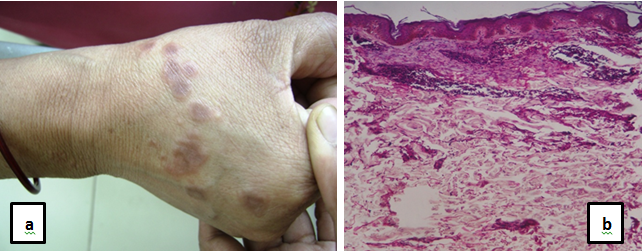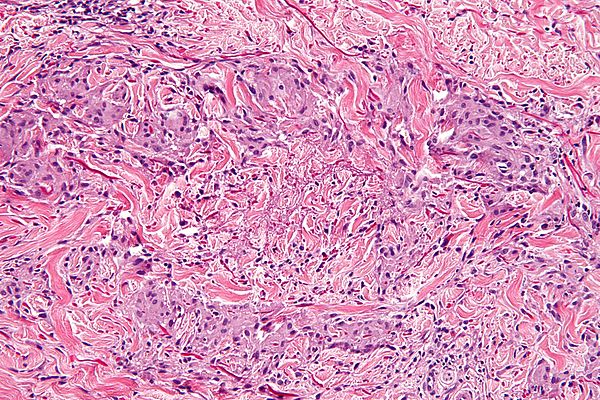Granuloma annulare, often abbreviated as GA, is a chronic skin condition that manifests as raised, reddish or skin-colored bumps forming ring-like patterns on the skin. While it is generally harmless and not contagious, its appearance can be concerning for those affected. This article delves into the causes, symptoms, diagnostic methods, and treatment options available for this condition.

Understanding Granuloma Annulare
Granuloma annulare is a benign inflammatory skin disorder that typically affects children, teenagers, and young adults, although it can occur at any age. It is characterized by small, firm bumps that form circular or semicircular patterns, most commonly on the hands, feet, wrists, and ankles. Despite its prevalence, the exact cause of granuloma annulare remains unclear.
Possible Causes of Granuloma Annulare
The precise cause of granuloma annulare has not been identified, but researchers have proposed several theories based on observed patterns and associations:
- Immune System Dysfunction: Some studies suggest that granuloma annulare may result from an abnormal immune response where the body mistakenly attacks its own skin cells. This theory is supported by the fact that the condition often resolves on its own, similar to other self-limiting immune reactions.
- Minor Skin Injuries: Trauma or minor injuries to the skin, such as insect bites or scratches, have been linked to the development of granuloma annulare in some cases. The skin’s healing process may trigger an inflammatory response that leads to the formation of lesions.
- Infections: Certain infections, including viral, bacterial, and fungal, have been associated with the onset of granuloma annulare. For instance, people with a history of recent infections may experience an outbreak of the condition.
- Underlying Health Conditions: Granuloma annulare has been observed more frequently in individuals with diabetes, thyroid disorders, and other systemic diseases. While no direct causal relationship has been established, these conditions may influence the immune system and contribute to the development of skin lesions.
- Genetic Predisposition: There is evidence to suggest that genetics may play a role in the development of granuloma annulare. Individuals with a family history of the condition may be at a higher risk of experiencing it themselves.
Symptoms of Granuloma Annulare
The symptoms of granuloma annulare are primarily cosmetic, as the condition does not usually cause pain or discomfort. However, the appearance of the lesions can lead to emotional distress or self-consciousness. Common symptoms include:
- Raised Bumps: Small, firm, and smooth bumps appear on the skin. These bumps are often flesh-colored, red, or slightly purple, depending on the individual’s skin tone.
- Ring-Shaped Patterns: Over time, the bumps may join together to form circular or semicircular rings. These patterns are most commonly found on the backs of the hands, fingers, feet, and ankles.
- Texture Changes: The affected areas may feel slightly rough or uneven compared to the surrounding skin. In some cases, the skin within the ring may appear normal or slightly sunken.
- No Pain or Itching: Unlike many other skin conditions, granuloma annulare typically does not cause itching, pain, or irritation. However, in rare cases, mild itching may occur.
- Variants: There are different types of granuloma annulare, including localized, generalized, subcutaneous, and perforating forms. Each type presents with slightly different symptoms and patterns.
Diagnosing Granuloma Annulare
Diagnosing granuloma annulare can be challenging because its symptoms resemble those of other skin conditions, such as ringworm, eczema, or psoriasis. A thorough evaluation by a dermatologist is essential to confirm the diagnosis. The following methods are commonly used:
Clinical Examination
A dermatologist will begin by examining the affected areas of the skin. They will look for characteristic features, such as the ring-shaped patterns and the texture of the lesions. The absence of itching or pain can also help differentiate granuloma annulare from other conditions.
Skin Biopsy
In cases where the diagnosis is uncertain, a skin biopsy may be performed. During this procedure, a small sample of the affected skin is removed and examined under a microscope. The presence of specific patterns of inflammation and tissue changes can confirm the diagnosis of granuloma annulare.
Laboratory Tests
While laboratory tests are not typically required to diagnose granuloma annulare, they may be ordered to rule out underlying health conditions or infections. Blood tests, for example, can help identify diabetes or thyroid disorders that may be associated with the condition.
Treatment Options for Granuloma Annulare
Granuloma annulare often resolves on its own without treatment, especially in cases of localized forms. However, for individuals who experience persistent or widespread lesions, several treatment options are available to improve the appearance of the skin. It is important to note that no single treatment works for everyone, and results may vary.
Topical Treatments
Topical treatments are often the first line of therapy for granuloma annulare. These treatments are applied directly to the affected areas and include:
- Corticosteroid Creams: These creams help reduce inflammation and flatten the raised bumps. They are most effective for mild cases and should be used under the guidance of a healthcare provider to avoid side effects like skin thinning.
- Retinoid Creams: Derived from vitamin A, retinoid creams can promote skin cell turnover and improve the appearance of lesions. They may take several weeks to show results.
Injections
For more severe or persistent cases, corticosteroid injections may be administered directly into the lesions. This method delivers a concentrated dose of medication to the affected area, reducing inflammation and speeding up healing. However, repeated injections may be necessary, and potential side effects include skin discoloration or thinning.
Phototherapy
Phototherapy involves exposing the skin to ultraviolet light under medical supervision. This treatment is particularly useful for generalized granuloma annulare, where lesions cover larger areas of the body. Phototherapy can help reduce inflammation and improve the appearance of the skin over time.
Oral Medications
In rare cases where granuloma annulare is widespread or resistant to other treatments, oral medications may be prescribed. These include:
- Antimalarial Drugs: Medications like hydroxychloroquine have been shown to be effective in treating granuloma annulare by modulating the immune response.
- Dapsone: This antibiotic has anti-inflammatory properties and can help reduce the size and number of lesions.
Lifestyle and Home Remedies
While medical treatments are often necessary, certain lifestyle changes and home remedies can complement professional care:
- Protecting the Skin: Avoiding trauma or irritation to the affected areas can prevent the worsening of lesions. Wearing protective clothing and using gentle skincare products can help.
- Managing Stress: Stress can exacerbate inflammatory conditions, so practicing relaxation techniques like yoga or meditation may be beneficial.
- Healthy Diet: Eating a balanced diet rich in vitamins and antioxidants can support overall skin health and immune function.
Living with Granuloma Annulare
While granuloma annulare is not a life-threatening condition, it can have a significant impact on an individual’s quality of life due to its visible nature. Understanding the condition and seeking appropriate care can help manage symptoms and improve confidence. Regular follow-ups with a dermatologist are recommended to monitor the progression of the condition and adjust treatment plans as needed.





